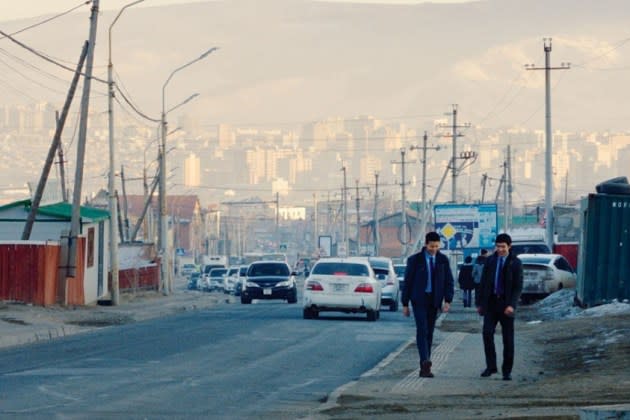Mongolian Cinema on the Cusp of International Breakout, Says Director of Venice Title ‘City of Wind’ (EXCLUSIVE)

“City of Wind” depicts a version of Mongolian everyday life that is both traditional and modern. Ulaanbaatar is shown as messy and sprawlingly urban in a fashion that will be familiar to millions of city dwellers in Asia — even if there are yurts in the front garden.
Presented in Venice’s Horizons section, and then Toronto, “City” starts as a story of a shaman, who is still of school age. Its opening scenes deliver a deliciously slow reveal of the boy savant and, soon after, a challenge to his supposed authority.
More from Variety
Roman Polanski Fails to Stir Up Venice Buzz as 'The Palace' Premieres to Meager Applause
'Aggro Dr1ft' Review: Harmony Korine Plays With Our Heads in Hard Reset on Filmmaking Rules
But by the second reel, it has done away with much of the exploration of the contradiction between the boy’s age and inexperience and his apparent insight. Instead, he fights with his catty sister and falls in love with the teen-girl who previously called him out. What follows is a wider, but milder, exploration of the juxtaposition of modernity and tradition.
The film’s director, Lkhagvadulam Purev-Ochir, is both a feature film debutant and a well-versed (and well-traveled) media professional. She has studied film and screenwriting in Turkey, Prague and Portugal, made shorts that went to Cannes and Sundance, and has taught history of film and film direction at the Mongolian School of Film, Radio and Television.
Despite that trajectory, she says she didn’t overthink her choices for a first film. “The idea appeared suddenly because it was based on a real experience. I was running late and didn’t get to see the shaman before the ceremony. And afterwards, while I was waiting my mother to come out, this young kid came and sat next to me. I found out he was the shaman only after leaving the apartment,” Purev-Ochir says.
“It was the contrast between these two identities that suddenly really spoke to me. … At that moment I understood why I was feeling so overwhelmed with my life. I wanted to express this feeling about being overwhelmed, feeling burdened and pulled in many directions.”
Purev-Ochir says she deliberately shied away from the more sensationalist aspects of shamanism. “The process can be lucrative, because people go to shamans when they’re in a lot of need, and they don’t hold back on the money. But that’s not what I wanted to explore.
“I’m really trying to paint this multiplicity of experiences, or viewpoints, but not in a conflicting way. [Instead, I’m interested in the] wide mosaic of contemporary Mongolian life, but not to exploit it dramatically. Modernity and tradition are often represented as conflicting. Mongolia for me, it’s not a place where we’re moving between two oppositions. The two things are more like a braid.”
Purev-Ochir is among a new generation of Mongolian filmmakers willing — and able — to look outwards and take part in the international indie film scene.
She began writing the script for “City of Wind” before being accepted to the Torino Script Lab in Italy. She was also accepted as a producer by Locarno’s Open Doors program in the year that it focused on Mongolia and Southeast Asia. It was there that she met and teamed up with her two French co-producers.
“I went through several different drafts, tried different things dramatically, including one where the girl’s mother opposes the relationship because the boy is a shaman. But ultimately, it didn’t feel true. And, instead, I simplified it down to its skeletal form. I tried not to embellish it and really just document life in Mongolia, how I’ve experienced it,” she says.
Casting the male lead was a challenge — “it was a very difficult age, I didn’t want someone who was already an adult, nor a child who could not carry the spiritual aspect,” she says — but eventually found Tergel Bold-Erdene through a director-friend.
“I texted, ‘Do you know anybody who’s around 17? Who wants to be an actor? And who’s not too handsome?’ She sent me a picture and we met the next day,” says Purev-Ochir.
The last couple of years have seen the launch of a French-style film council in in Mongolia and the establishment of a production incentives system. “I feel very privileged because filmmakers who came before me had to fund their films in a different way. Now, there are all these opportunities and possibilities for coproduction. I hope that is going to bring Mongolian films to a world platform. This is what we are really lacking. But now that all of the kind of the tools are in place, I think there is no stopping us,” says Purev-Ochir.
Since the fall of communism, [the Mongolian film industry] became largely privatized. To date it was mainly commercial because filmmakers had to fund their own films.
“Independent filmmakers were always there, but working with VHS tapes and minimal resources,” says Purev-Ochir. “Now, I really believe that arthouse filmmakers are going to finally have the opportunities that they lacked so much. Myself, I have three different projects in development, all about Mongolia and all set in Mongolia.”
Best of Variety
Oscars Predictions: Best Actress - Festivals Declare Emma Stone and Jodie Comer Awards Contenders
The Best Early Labor Day Sales to Shop Right Now: Le Creuset, Nespresso, North Face and More
Sign up for Variety’s Newsletter. For the latest news, follow us on Facebook, Twitter, and Instagram.
